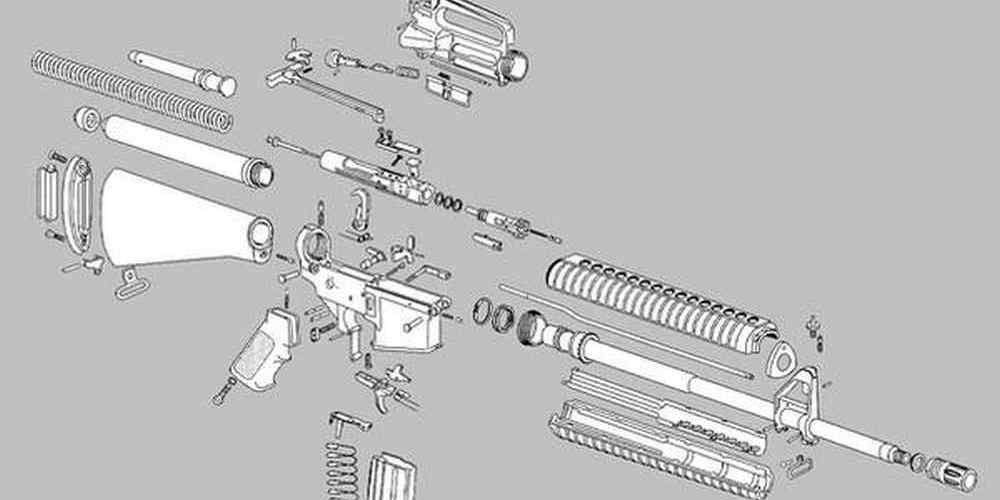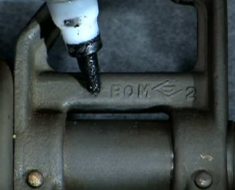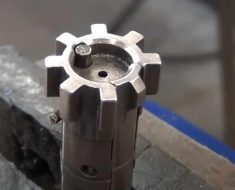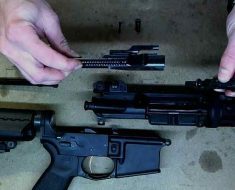“Fine-tune your AR15 for precision performance.”
Adjusting Trigger Weight on AR15s
If you own an AR15, you know how important it is to have a trigger that is reliable and consistent. However, sometimes you may encounter issues with the trigger weight that can affect your shooting experience. In this article, we will discuss some common trigger weight issues in AR15s and how you can troubleshoot and adjust them to ensure optimal performance.
One of the most common issues with trigger weight in AR15s is a trigger that is too heavy. This can make it difficult to shoot accurately and can cause fatigue during extended shooting sessions. If you find that your trigger weight is too heavy, there are a few things you can try to troubleshoot the issue.
First, check to see if there is any debris or dirt in the trigger mechanism that may be causing the trigger weight to feel heavier than normal. If you notice any buildup, carefully clean the trigger mechanism with a solvent and a brush to remove any obstructions that may be causing the issue.
If cleaning the trigger mechanism does not solve the problem, you may need to adjust the trigger weight using the adjustment screws on your AR15. Most AR15 triggers come with adjustable screws that allow you to fine-tune the trigger weight to your liking. To adjust the trigger weight, first, make sure your AR15 is unloaded and the safety is engaged. Then, use an Allen wrench to turn the adjustment screws clockwise to increase the trigger weight or counterclockwise to decrease it. Make small adjustments and test the trigger weight after each adjustment until you find the optimal setting for your shooting style.
Another common trigger weight issue in AR15s is a trigger that is too light. While a light trigger can make shooting easier, it can also be dangerous if it is too sensitive and prone to accidental discharges. If you find that your trigger weight is too light, there are a few steps you can take to troubleshoot and adjust the issue.
First, check to see if the trigger spring is properly installed and functioning correctly. If the trigger spring is damaged or not installed correctly, it can cause the trigger weight to feel lighter than normal. Replace the trigger spring if necessary and test the trigger weight to see if the issue is resolved.
If the trigger spring is not the issue, you may need to adjust the trigger weight using the adjustment screws on your AR15. Follow the same steps as mentioned earlier to adjust the trigger weight to your liking. Make small adjustments and test the trigger weight after each adjustment to ensure that it is safe and comfortable for you to shoot.
In conclusion, troubleshooting trigger weight issues in AR15s is essential to ensure optimal performance and safety while shooting. By following the steps outlined in this article, you can identify and adjust trigger weight issues in your AR15 to improve your shooting experience. Remember to always handle your AR15 safely and follow proper maintenance procedures to keep your firearm in top condition.

Common Trigger Weight Problems in AR15s
If you own an AR15, you know how important it is to have a properly functioning trigger. The trigger weight, or the amount of force required to pull the trigger and fire the gun, is a critical aspect of the AR15’s performance. However, sometimes AR15 owners may encounter issues with trigger weight that can affect the gun’s accuracy and overall performance. In this article, we will discuss some common trigger weight problems in AR15s and how to troubleshoot them.
One common issue that AR15 owners may encounter is a trigger that feels too heavy. This can make it difficult to shoot accurately and can cause fatigue during extended shooting sessions. There are a few possible reasons why a trigger may feel too heavy. One common cause is a dirty or fouled trigger mechanism. Over time, dirt, debris, and fouling can build up in the trigger mechanism, causing it to feel gritty and heavy. To fix this issue, you can try cleaning the trigger mechanism with a solvent and lubricating it with a high-quality gun oil.
Another possible cause of a heavy trigger is a worn or damaged trigger spring. The trigger spring is responsible for returning the trigger to its forward position after it has been pulled. If the trigger spring is worn or damaged, it may not be able to provide enough tension to return the trigger to its proper position, causing the trigger to feel heavy. In this case, you may need to replace the trigger spring with a new one to restore proper trigger weight.
On the other hand, some AR15 owners may experience the opposite problem – a trigger that feels too light. A trigger that is too light can be dangerous, as it can lead to accidental discharges and unsafe shooting conditions. One possible cause of a trigger that feels too light is an improperly adjusted trigger pull weight. Most AR15 triggers are adjustable, allowing you to customize the trigger pull weight to your liking. If your trigger feels too light, you may need to adjust the trigger pull weight to a higher setting to ensure safe and reliable shooting.
Another possible cause of a trigger that feels too light is a worn or damaged sear or hammer. The sear and hammer are critical components of the trigger mechanism that work together to release the firing pin and fire the gun. If the sear or hammer is worn or damaged, it may not provide enough resistance to prevent the trigger from being pulled too easily, causing the trigger to feel too light. In this case, you may need to replace the sear or hammer with new ones to restore proper trigger weight.
In conclusion, troubleshooting trigger weight issues in AR15s can be a challenging but necessary task for any AR15 owner. By understanding the common causes of trigger weight problems and how to troubleshoot them, you can ensure that your AR15 performs reliably and safely. Whether you are dealing with a trigger that feels too heavy or too light, taking the time to diagnose and fix the issue will help you get the most out of your AR15 and enjoy shooting it for years to come.
Troubleshooting Trigger Weight Inconsistencies in AR15s
If you’re a proud owner of an AR15, you know how important it is to have a smooth and consistent trigger pull. However, sometimes you may encounter issues with the trigger weight, which can affect your shooting accuracy and overall performance. In this article, we will discuss some common trigger weight problems in AR15s and provide troubleshooting tips to help you resolve them.
One of the most common issues with trigger weight in AR15s is a heavy or gritty trigger pull. This can be caused by a variety of factors, such as dirt and debris buildup, worn out components, or improper lubrication. To troubleshoot this issue, start by cleaning your trigger assembly thoroughly with a solvent and a brush. Make sure to remove any dirt, grime, or debris that may be causing the trigger to feel heavy or gritty.
Next, inspect the trigger components for any signs of wear or damage. Check the trigger springs, sear surfaces, and hammer for any signs of wear or deformation. If you notice any worn out parts, consider replacing them with high-quality aftermarket components to improve the overall performance of your trigger assembly.
Another common trigger weight issue in AR15s is a light or inconsistent trigger pull. This can be caused by a variety of factors, such as weak trigger springs, improper adjustment, or a dirty trigger assembly. To troubleshoot this issue, start by checking the trigger springs for any signs of wear or deformation. If the springs are weak or damaged, consider replacing them with stronger aftermarket springs to improve the trigger pull weight.
Next, check the trigger adjustment screws to ensure they are properly set. If the trigger pull weight is too light or inconsistent, try adjusting the screws to increase the tension on the trigger assembly. Make small adjustments and test the trigger pull weight after each adjustment to find the optimal setting for your shooting style.
If you are still experiencing trigger weight issues after cleaning and inspecting your trigger assembly, consider taking your AR15 to a qualified gunsmith for further diagnosis and repair. A professional gunsmith will have the knowledge and expertise to identify and resolve any underlying issues with your trigger assembly to ensure a smooth and consistent trigger pull.
In conclusion, troubleshooting trigger weight issues in AR15s can be a challenging task, but with the right knowledge and tools, you can easily resolve these problems and improve the overall performance of your rifle. By following the tips outlined in this article, you can ensure a smooth and consistent trigger pull every time you take your AR15 to the range. Remember to always practice proper gun safety and maintenance to keep your rifle in top condition for years to come.
Upgrading Trigger Components for Better Weight Control in AR15s
If you’re a proud owner of an AR15 rifle, you know that one of the key components that can greatly affect your shooting experience is the trigger. The trigger weight, or the amount of force required to pull the trigger and fire the gun, plays a crucial role in accuracy and overall performance. However, sometimes AR15 owners may encounter issues with trigger weight that can affect their shooting experience. In this article, we will discuss some common trigger weight issues in AR15s and how you can troubleshoot them by upgrading trigger components for better weight control.
One of the most common trigger weight issues that AR15 owners face is a trigger that is too heavy. A heavy trigger can make it difficult to shoot accurately and can cause fatigue during extended shooting sessions. If you find that your AR15’s trigger weight is too heavy, one possible solution is to upgrade to a lighter trigger. There are many aftermarket trigger options available that can help reduce trigger weight and improve your shooting experience.
Another trigger weight issue that AR15 owners may encounter is a trigger that is too light. A trigger that is too light can be dangerous, as it can lead to accidental discharges. If you find that your AR15’s trigger weight is too light, one possible solution is to upgrade to a heavier trigger. This can help increase the amount of force required to pull the trigger and reduce the risk of accidental discharges.
In addition to upgrading the trigger itself, there are other components that can affect trigger weight in an AR15. One common culprit is the trigger spring. If the trigger spring is too stiff, it can increase trigger weight. On the other hand, if the trigger spring is too weak, it can decrease trigger weight. By replacing the trigger spring with a spring that is the appropriate strength for your shooting preferences, you can help achieve the desired trigger weight for your AR15.
Another component that can affect trigger weight in an AR15 is the hammer spring. The hammer spring is responsible for striking the firing pin and igniting the primer. If the hammer spring is too stiff, it can increase trigger weight. If the hammer spring is too weak, it can decrease trigger weight. By replacing the hammer spring with a spring that is the appropriate strength for your shooting preferences, you can help achieve the desired trigger weight for your AR15.
In conclusion, trigger weight is a crucial factor in the performance of an AR15 rifle. If you encounter trigger weight issues with your AR15, there are several troubleshooting steps you can take to improve your shooting experience. By upgrading trigger components such as the trigger, trigger spring, and hammer spring, you can achieve better weight control and enhance your overall shooting experience. Remember to always prioritize safety when making any modifications to your AR15’s trigger components. Happy shooting!
Tips for Maintaining Consistent Trigger Weight in AR15s
If you own an AR15, you know how important it is to maintain consistent trigger weight for optimal performance. However, sometimes issues can arise that affect the trigger weight, leading to inconsistencies in your shooting experience. In this article, we will discuss some common problems that can cause trigger weight issues in AR15s and provide tips on how to troubleshoot and resolve them.
One of the most common reasons for trigger weight issues in AR15s is a dirty or fouled trigger mechanism. Over time, dirt, debris, and carbon buildup can accumulate in the trigger assembly, causing the trigger to feel gritty or heavy. To address this issue, it is important to regularly clean and lubricate the trigger mechanism. Use a cleaning solvent and a brush to remove any buildup, then apply a light coat of lubricant to ensure smooth operation.
Another potential cause of trigger weight issues is worn or damaged trigger components. If the trigger springs or sear surfaces are worn or damaged, it can lead to inconsistent trigger weight. In this case, it may be necessary to replace the affected components to restore proper function. Be sure to use high-quality replacement parts from a reputable manufacturer to ensure reliability and safety.
In some cases, trigger weight issues can be caused by improper adjustment of the trigger pull weight. Many AR15s come with adjustable triggers that allow you to customize the pull weight to your preference. If you have adjusted the trigger weight and are experiencing issues, it may be necessary to reset the adjustment to the factory settings. Refer to your owner’s manual for instructions on how to properly adjust the trigger pull weight.
Another potential cause of trigger weight issues is a loose or improperly installed trigger assembly. If the trigger components are not securely in place, it can lead to inconsistencies in trigger weight. Check to ensure that all screws and pins are properly tightened and that the trigger assembly is correctly installed in the lower receiver. If necessary, disassemble the trigger assembly and reassemble it according to the manufacturer’s instructions.
If you have tried the above troubleshooting steps and are still experiencing trigger weight issues, it may be necessary to seek professional help. A gunsmith or firearms technician can inspect your AR15 and diagnose any underlying issues that may be causing the problem. They can also make any necessary repairs or adjustments to ensure that your trigger weight is consistent and reliable.
In conclusion, maintaining consistent trigger weight is essential for optimal performance and accuracy in your AR15. By regularly cleaning and lubricating the trigger mechanism, replacing worn components, adjusting the trigger pull weight properly, and ensuring that the trigger assembly is securely installed, you can troubleshoot and resolve trigger weight issues in your AR15. If you are still experiencing problems, don’t hesitate to seek professional help to ensure that your firearm is functioning safely and reliably.








